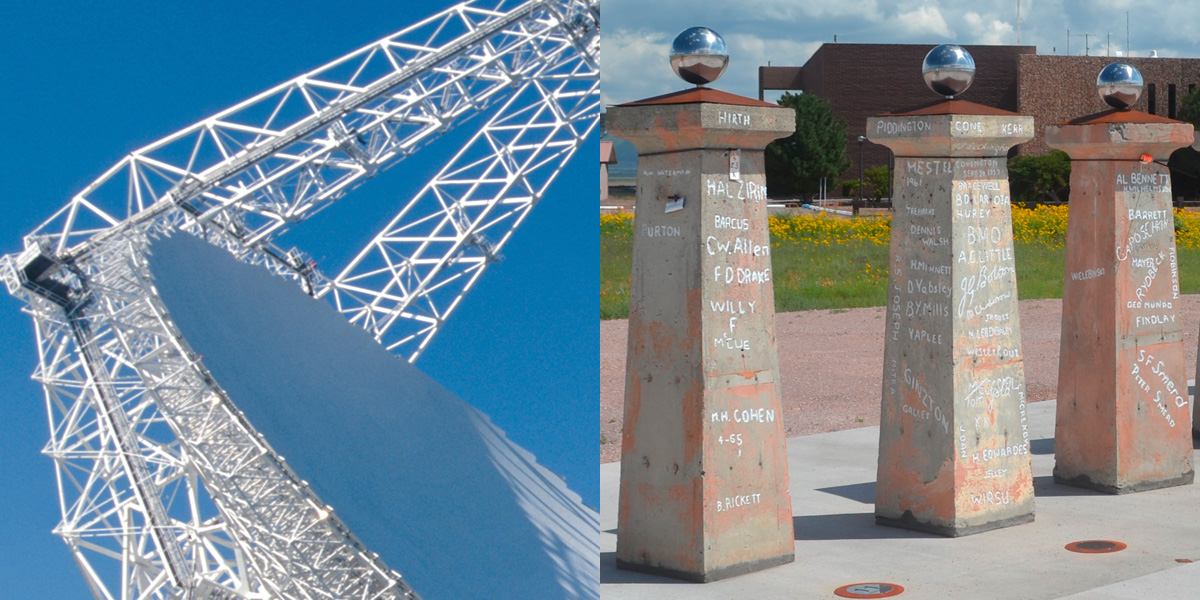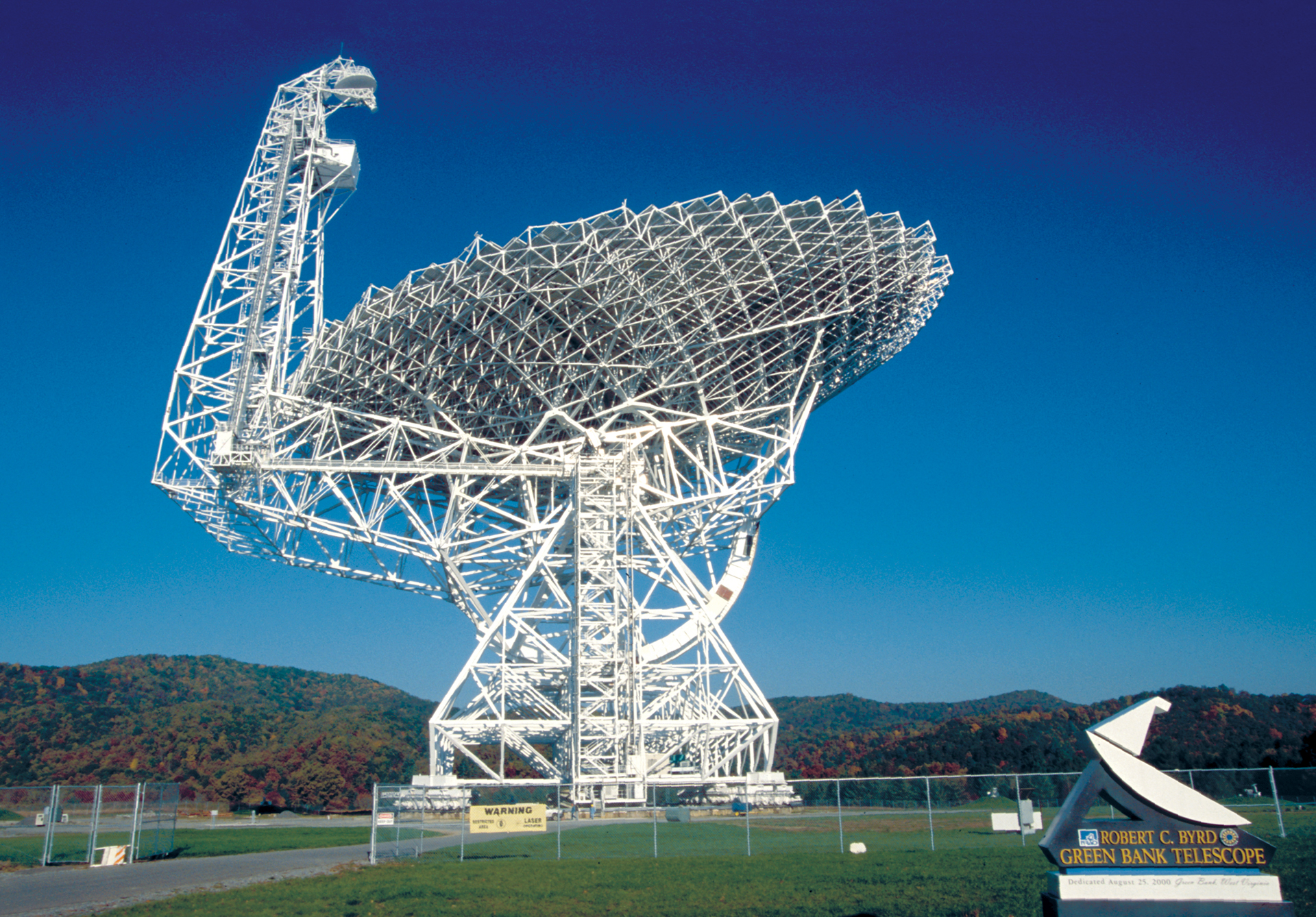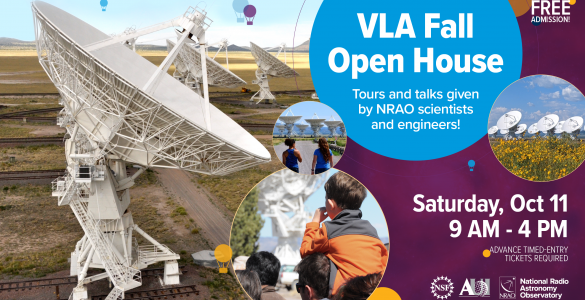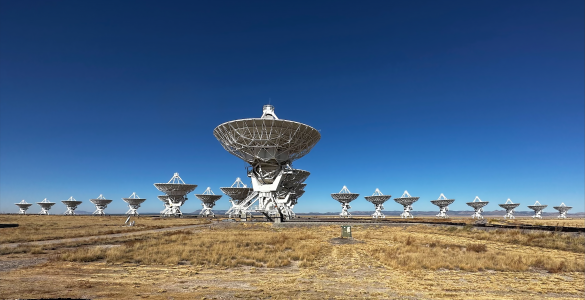Topics in This Issue:
Two radio antennas 6,400 miles apart were joined together to become one instrument, offering new opportunities in astrophysical research.
A new take on an old technology marks the passing of time and adds to the educational experience at the NRAO’s Very Large Array.
NRAO astronomer Felix “Jay” Lockman is honored by his colleagues by being elected a Fellow of the American Association for the Advancement of Science.
1. Long-distance ‘Fringes’ Achieved between West Virginia and Shanghai
For nearly 50 years, NRAO’s radio telescopes have been linked with other radio telescopes around the world to obtain high-resolution images of quasars, cosmic masers, and other celestial radio sources. Recently, the newly completed 65 meter diameter radio telescope located near Shanghai, China, was linked with the NRAO’s 100 meter Robert C. Byrd Green Bank Telescope (GBT) in Green Bank, West Virginia. The two telescopes are more than 10,300 kilometers (6,400 miles) apart, yet were able to be linked together as if they were one single instrument. To achieve this feat, the signals received at the two radio telescopes were synchronized by atomic clocks at each facility with an accuracy of a few billionths of a second and were recorded on magnetic disks of the type used in typical computer systems. Together, these two large U.S. and Chinese radio telescopes formed a very sensitive radio interferometer, with practically the longest spacing possible on the Earth. Scientists refer to the signal produced by a pair of linked antennas as “fringes.”
2. Modern and Historic Technology Merge at Newly Unveiled VLA Sundial
The Karl G. Jansky Very Large Array (VLA) in New Mexico is now home to a new walk-through sundial built, in part, with historical scientific artifacts. This unique timepiece, which was named in honor pioneering radio astronomer Ronald Bracewell, blends fundamental science with historical milestones of radio astronomy. Among the artifacts incorporated into the sundial are concrete piers that originally held dish antennas for a California radio observatory Bracewell built and operated for two decades starting in the 1960s. Bracewell used the piers as a novel “guest book,” having visiting astronomers chisel their signatures into the concrete. He accumulated more than 200 of these signatures from many of the leading pioneers of radio astronomy, observatory directors from around the world, and two Nobel Prize recipients. Bracewell’s observatory closed in 1980. In 2012, ten of the concrete piers were transported to the VLA to become part of the new sundial. The markers that indicate the time of day are embedded in a central concrete slab, where the shadow of a metal sphere mounted atop a post can fall on them.
This sundial, which is open to the public as part of the VLA walking tour, is unique in that it allows visitors to locate the approximate position in the sky of three celestial objects that played important roles in radio astronomy — two radio galaxies and the debris from an exploded star. The sundial is a tribute to Bracewell, an Australian native and Stanford professor who developed many of the mathematical techniques used today to make images with the VLA and other radio telescopes. It was designed by Woody Sullivan at the University of Washington, with the installation managed by NRAO astronomer Miller Goss. Funding came through contributions from Friends of the Bracewell Observatory and Associated Universities, Inc. (AUI).
3. NRAO Astronomer Elected Fellow of AAAS
Felix J. “Jay” Lockman, an astronomer at the National Radio Astronomy Observatory in Green Bank, W.Va., has been named a Fellow of the American Association for the Advancement of Science (AAAS). He was honored for his “significant studies of neutral hydrogen in our galaxy and others, including the discovery of the ‘Lockman Hole,’ and for service to U.S. radio astronomy.” The Lockman Hole is an area of the sky near the constellation Ursa Major that has a remarkably low concentration of neutral atomic hydrogen. This makes it a useful window on the distant universe for certain X-ray and ultraviolet observations. Lockman received his Ph.D. from the University of Massachusetts, Amherst, in 1979 and began work at NRAO in 1978.
The tradition of AAAS Fellows began in 1874. Election as a AAAS Fellow is an honor bestowed upon AAAS members by their peers. This year 388 members have been awarded this honor. New Fellows will be presented with an official certificate and a gold and blue rosette pin at the 2014 AAAS Annual Meeting in Chicago.
The National Radio Astronomy Observatory is a facility of the National Science Foundation, operated under cooperative agreement by Associated Universities, Inc.
###
Media Contacts:
Charles E. Blue, Public Information Officer
(434) 296-0314; cblue@nrao.edu
Dave Finley, Public Information Officer
(575) 835-7302; dfinley@nrao.edu

















